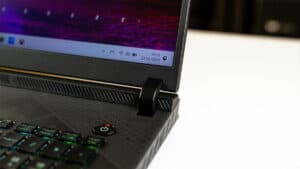Best OLED laptop in April 2024 for creatives, gamers & more
We discuss the best OLED laptops in 2024, covering a variety of types and use-cases
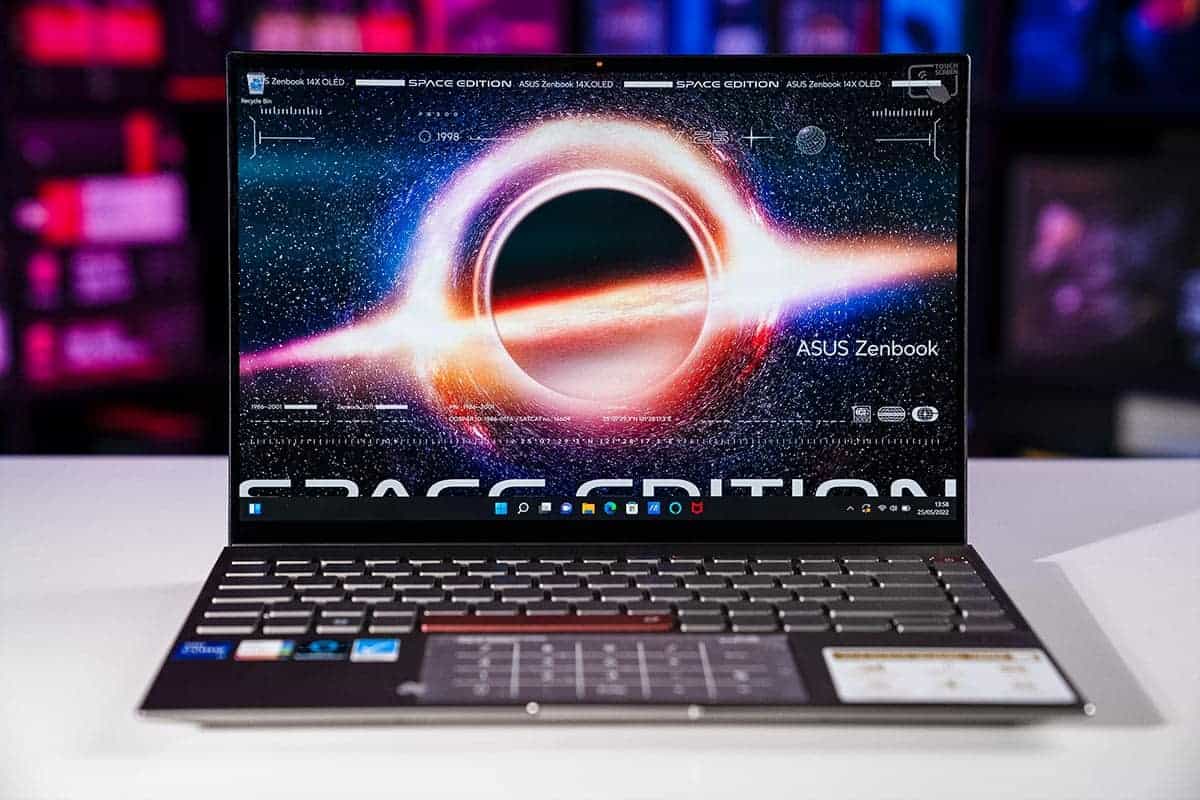
WePC is reader-supported. When you buy through links on our site, we may earn an affiliate commission. Prices subject to change. Learn more
This guide will help you find the best OLED laptop in 2024 for your needs, covering various use-cases and price points. An OLED laptop offers next-level image quality on your device’s display. The screens of these laptops are all lush, colorful, and have a great contrast ratio; usually also having a higher peak brightness than you will find in a conventional IPS/TN/VA display. Having said that, some OLED screens are better than others, not to mention the quality of the laptop they are attached to besides this, so read below for our breakdown of the best OLED laptops on the market.
We’re always looking to update our guides with the latest and best products, so keep checking back to see if anything new has made the cut. If you ain’t got time to read and want something fast then the HP Spectre x360 is the best 2-in-1 out there, the Dell XPS 15 is the best MacBook replacement option for general productivity, and the MSI Raider GE67HX is the best option for gamers. Read our Things to consider when buying an OLED laptop section further down the page if you want to get a bit more information before you pull the trigger.
Should I buy an OLED laptop?
If you are a creative who wants a laptop with a wide color gamut that they can do color-accurate work on (be it photo editing, graphic design, color grading of video footage etc.), then an OLED laptop would be an ideal choice. Equally, if you’re just looking for a laptop with a display that really pops for watching films on, then the OLED could be right for you. Until recently, those looking for a gaming laptop would have bee advised to look elsewhere (such as our best gaming laptop guide) as the maximum refresh rate on OLED laptops was usually capped at 60Hz. Recently however, there have been some OLED gaming laptops released that are well worth considering, which we’ll list below.
Read our Things to consider when buying an OLED laptop section below for more information. If you’re looking for a laptop for your studies also consider reading our best laptop for students guide.
Today’s best laptop deals
- CORSAIR – Voyager a1600 16” 240Hz Gaming Laptop QHD – Save $500
- Acer Nitro 5 15.6″ Gaming Laptop – Save $330 NOW!
- ASUS ROG X13 Touchscreen Gaming Laptop – $768 off
- Apple 2023 MacBook Air Laptop with M2 chip – Save 19% now!
- Alienware X17 R2 (360Hz FHD, RTX 3070 Ti) – Save 17% now!
- Lenovo ThinkPad X1 Carbon Gen 10 (14″) (i5-1260P) – SAVE 18% NOW!
- Apple 2020 MacBook Air – $200 off
- Apple 2020 MacBook Air (13″, M1) – Save 25% NOW!
- Apple MacBook Air 13.3″ (2020) (M1 chip) – Save $249 now!
- Lenovo ThinkPad E16 Business Laptop – Save 22% NOW!
- ASUS ROG Strix Scar 15 (2021) Gaming Laptop – Save 33% NOW!
- MSI Pulse GL66 15.6″ FHD 144Hz Gaming Laptop – Save 24%
The Best OLED laptop 2024: reviews
A uniquely powerful OLED gaming laptop

MSI Raider GE67 HX 15.6″ (240Hz OLED)
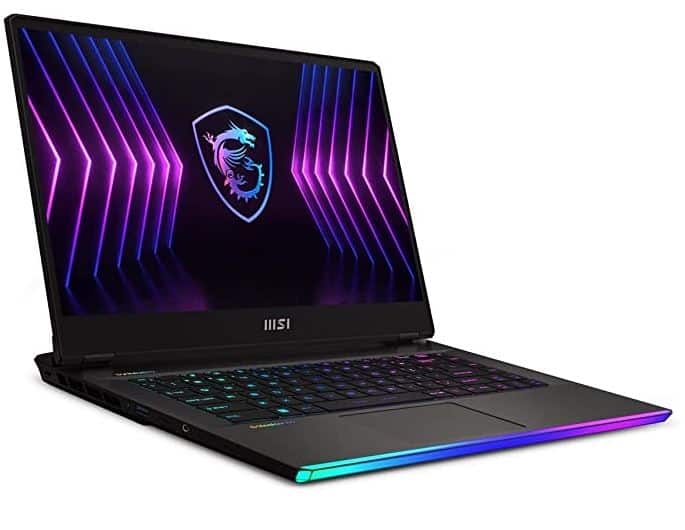
CPU
Intel Core i7-12800HX / i9-12900HX
Graphics Card
NVIDIA GeForce RTX 3070 Ti / 3080 Ti
RAM
32GB DDR5 RAM
Storage
1TB SSD
Max Refresh Rate
240Hz
Resolution
2560 x 1440
- Uniquely powerful OED gaming laptop
- 240Hz refresh rate
- High TGP GPU
- powerful CPU
- good build quality
- good selection of ports
- Not the cheapest
The MSI Raider GE67 HX is a 240Hz 1440p OLED powerhouse of a laptop. Coming equipped with either RTX 3070 Ti or RTX 3080 Ti graphics cards, plus either Intel Core i7-12800HX or Intel Core i9-12900HX processor. This is by far the best gaming laptop with an OLED screen you’ll find, and is quite a unique proposition overall.
The graphics card options are of the highest TGP available, and you’re guaranteed to demolish any game played at the native QHD resolution. The high refresh rate means you can indulge in competitive gaming, and the OLED display lends itself to creative use and viewing tv/film media, You get the standard high build quality that you get with all MSI Raiders, plus the latest DDR5 RAM, a great selection of ports, and 1TB of SSD storage.
Basically the only downside of this fine machine is the asking price, but considering what you get for the money, relative to the rest of the market it’s not actually that expensive. So snap yours up now!
A Premium Quality 2-In-1 OLED Laptop
HP Spectre x360 14 OLED
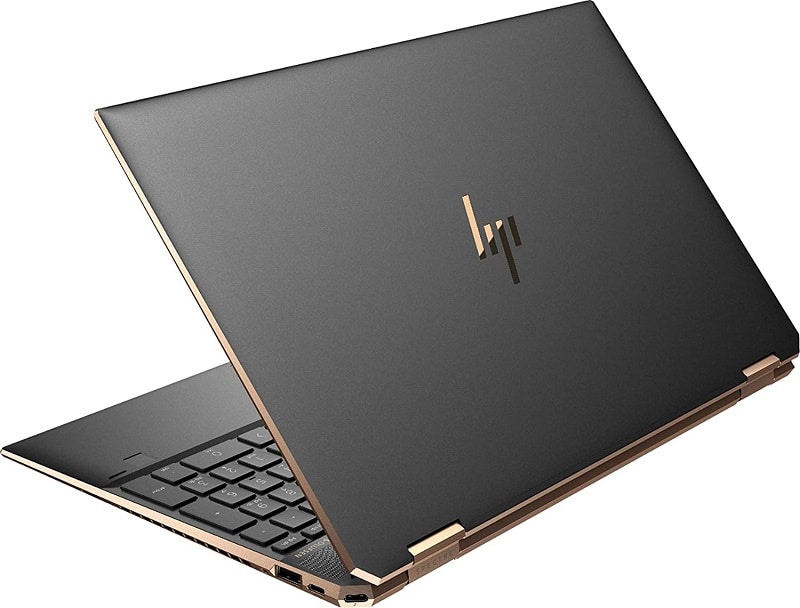
CPU
Intel Core i7-1195G7
Graphics Card
Intel Iris Xe (iGPU) / Nvidia GeForce MX450 (2GB)
RAM
8GB/16GB
Max Refresh Rate
60Hz
Resolution
3000 x 2000
Screen Size
13.5”
- 100% sRGB & 100% DCI-P3 coverage
- OLED screen has superb contrast ratio
- good peak brightness
- unique 3:2 aspect ratio
- superb keyboard & good trackpad
- stylus pen included
- good port coverage
- fingerprint scanner
- superb build quality & aesthetics
- expensive
- webcam could be better
- screen is only 13.5”
The HP Spectre x360 14 equipped with OLED 3000 x 2000 display is not a cheap laptop, but it is definitely a quality piece of technology, and one of the best all-round 2-in-1 laptops out at the moment: these combine the form factor of a laptop with an ability to fold backward into a tablet-like device. This plus the touch screen make the Spectre x360 a great flexible machine for creatives on the move. The 3K2K OLED display has superb contrast, a fairly high peak brightness of around 340 nits, and a superb color gamut, covering well over 100% sRGB and 100% DCI-P3, making it ideal for any sort of color-accurate workflow. Although the 14 in the name would indicate a 14-inch laptop, the actual diagonal screen size of the HP Spectre x360 is 13.5-inches (technically correct if you’re rounding up but still, a bit sly from HP).
The OLED version is powered by up to an Intel Core i7-1195G7 CPU with either Intel Iris Xe onboard graphics or the more powerful Nvidia GeForce MX450 (2GB). You won’t be able to do much in the way of gaming on this machine, but combined with 16GB of RAM then this will definitely do well for light workstation use.
Although looks are subjective, most people would agree this is a nice-looking laptop. We think the metallic detailing around the edges and joints and the thin bezels around the screen give the machine a quality aesthetic. In terms of build quality, the Spectre x360 is the best 2-in-1 device you will find, with the hinge joint in particular (often a weak point on cheaper models) feeling sturdy, which is exactly what you’d want. Most of the machine is made from aluminium, meaning the chassis feels robust with little flex, though it remains not too heavy despite this.
The keyboard of the HP Spectre x360 14 is particularly good for such a thin machine: it uses scissor switches and has 1.5mm key travel, and is the best typing experience you will get from a 2-in-1 laptop, with nice tactile responsiveness as well as nicely sized and arranged keys. The trackpad is also of good quality, and features a fingerprint scanner for added security. The port coverage is also good despite its slimline design, with two USB-C ports that support Thunderbolt 4 and DisplayPort 1.4, a USB-A port, and a microSD card reader in addition to the usual headphone/mic jack. A nice selection for any content creator needs. The included stylus pen is of decent quality, has two programmable buttons, and is rechargeable via USB-C.
The speakers are solid (for a laptop), with respectable bass replication and sound quality, though not quite up there with the MacBook’s. The webcam is unfortunately not the best, and its image quality (not terrible but not great) is one of the few criticisms we can level at this machine, though it does at least have InfraRed functionality supporting Windows Hello.
A superbly slimline OLED laptop that competes with the MacBook Air
Dell XPS 15 (15-inch, OLED)
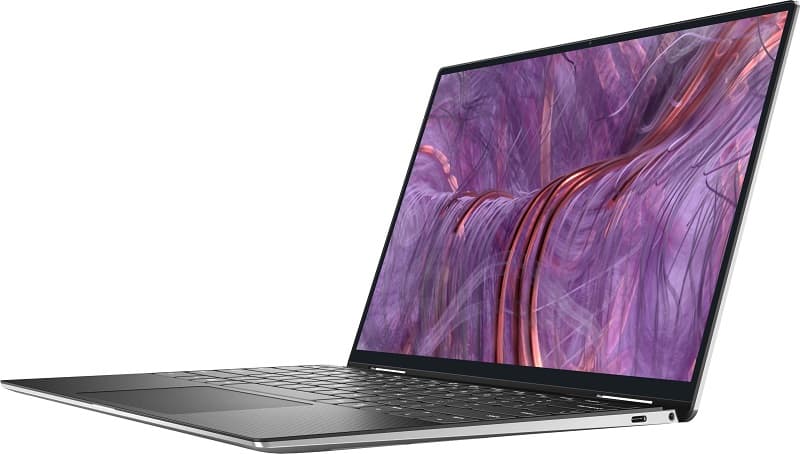
CPU
Intel Core i9-12900HK
Graphics
Nvidia GeForce RTX 3050 Ti
RAM
16GB / 32GB / 64GB
Storage
1TB / 2TB PCIe NVMe SSD
Screen Size
15.6”
Max Refresh Rate
60Hz
- 100% sRGB & 100% DCI-P3 color coverage
- OLED display with superb contrast ratio
- very high peak brightness
- 16:10 aspect ratio gives more vertical space
- great keyboard & touchpad
- Thunderbolt 4 & SD card reader support
- superb build quality & aesthetics
- quiet fans
- thin & portable
- expensive
- no USB-A / USB-B ports
The Dell XPS 15 is a major challenger of the Apple MacBook Air’s throne for the best high-quality ultraportable notebook laptop, with the traditional clamshell design and one of the nicest looking aesthetics of any laptop out there. It isn’t designed to be a gaming machine, but a premium general use and light workstation laptop, for office workers, writers, and creatives who don’t need a lot of rendering power in their workflows. That being said, the Intel Core i9-12900HK CPU is powerful, and the RTX 3050 Ti graphics card, whilst substantially weaker than its older RTX 3060 sibling, is still a dedicated graphics card capable of light gaming and rendering workloads.
The 3456 x 2160 (a.k.a 3.5K) screen has a 16:10 aspect ratio, which gives you a bit of extra headroom and vertical space on the page when reading documents, web browsing, or editing an image. Bezels are also pleasingly thin, maximizing the screen space you do have. The display itself is sublime, covering 100% of both the sRGB and 100% DCI-P3 spectrum, with a sensational 100,000:1 contrast ratio and the brightest screen on this page at 500nits on max settings. This makes the Dell XPS 15 a great choice for photographers, video editors, graphic designers, and others involved in color-accurate work.
Build quality on this machine is top-notch, and it’s genuinely impressive how sturdy the Dell XPS 15 feels despite being so thin. The membrane keyboard is a pleasure to type on, even if it doesn’t quite match up to the HP Spectre x360 with its superior travel distance, and the trackpad is also pleasingly responsive and accurate. Fan noise is also kept to a minimum, making this the ideal working laptop when on public transport or a quiet study area. The microSD card reader it comes with is another welcome feature, particularly one that runs as fast and efficiently as this one. The speakers are respectable, but not as good as those of the HP Spectre x360. Battery life on the OLED version of the Dell XPS 15 lasts for 7-8 hours, which is decent for this kind of display, and with a CPU and GPU of this power, if not the best out there. The 1080p webcam does have InfraRed technology but is merely adequate in terms of quality, along with the internal mic.
Besides these points though, the only real downside of this OLED laptop is the price, which can be brought down a bit if you opt for the less powerful CPU, less RAM, and a smaller SSD size, but we’re still talking a significant price tag. Still compared to the MacBook it doesn’t seem so unreasonable, and you do get one of the nicest designed laptops on the market.
The perfect AMOLED/ OLED laptop to mix color workflows with gaming
Gigabyte Aero 17 YD (HDR, 60Hz, RTX 3080)
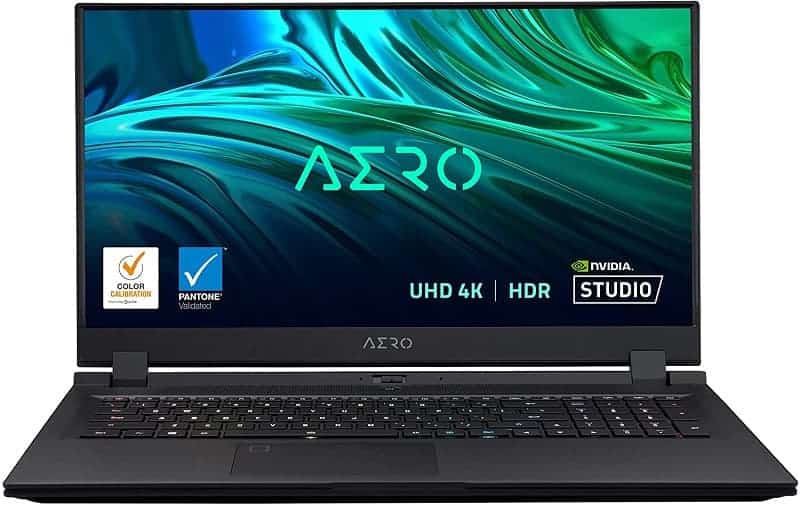
CPU
Intel Core i9-11980HK
Graphics
Nvidia RTX 3080 (100-140W)
RAM
32GB
Storage
512GB SSD + 1TB SSD
Screen Size
17.3”
Max Refresh Rate
60Hz
- AMOLED display has superb color gamut and accuracy
- superb contrast & brightness (DisplayHDR 400 certified)
- good array of ports including Thunderbolt
- flexible specification options
- Low TGP RTX 3080 GPU
- No G-Sync support
- loud fans
- underchin webcam
Straight away we should point out that the Gigabyte Aero 15 4K stretches our definition of ‘gaming laptop’ somewhat in that it only has a 60Hz refresh rate display, which effectively caps any game you play to 60FPS. At this present time though, this is the best you can hope for with an OLED/AMOLED screen, and the Gigabyte Aero does at least comes with options for powerful enough components that you’ll be able to consistently reach the 60FPS mark in games on the higher settings (assuming you set your in-game resolution to 1080p that is).
The maximum specs top out at the Intel Core i9-11980HK and Nvidia GeForce RTX 3080 graphics card. Although the TGP of the RTX 3080 is relatively low compared to some of our favorite gaming laptop picks, it’s still a powerful graphics card at the end of the day. You can spec out the RAM up to 32GB of DDR4 and have up to a 1.5 TB SSD, though you can also upgrade this further yourself.
Besides the refresh rate, the 4K AMOLED display on this machine is absolutely fantastic with 100% sRGB and DCI-P3 gamut coverage, and a Delta score of less than 1, making it very color-accurate and a superb choice for anyone looking to do a color-based workflow. Both the contrast and peak brightness on the screen are superb, and it comes with HDR support, specifically DisplayHDR 400 certification. The more recent versions of the Aero 15 come with Thunderbolt support and there is a good range of ports besides this, including a UHS-II SD card reader. The full-sized keyboard is of a respectable standard, as is the trackpad, and the latter comes with a fingerprint reader.
In terms of the drawbacks, the 720p webcam is placed in that irritating under the chin position that some laptop makers continue to use. Fan noise is also unfortunately loud at times, even on battery saver mode, though on the plus side the laptop does run relatively cool considering its powerful components. The laptop lacks G-Sync support, making the occasional bit of screen tearing more likely in games. Whilst of generally okay build quality, it’s not as nice looking as the other selections on this list, and is certainly on the thicker and heavier side, making it not the most portable. Still, everything considered, this is a great laptop for creatives who want to do some gaming on the side.
An affordable thin & light OLED laptop with good battery life
ASUS ZenBook 13 (OLED, AMD)
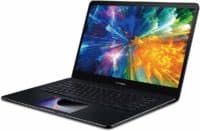
CPU
AMD Ryzen 7 5700U / 5800U
Graphics
Radeon iGPU
RAM
8GB/16GB DDR4
Storage
512GB / 1TB SSD
Screen Size
13.3”
Max Refresh Rate
60Hz
- great CPU performance
- OLED display with great contrast
- good value
- thin & light
- great battery life
- decent speakers
- no touchscreen
- no headphone jack
- poor webcam
The Asus ZenBook 13 (UM325) is not only the most affordable OLED laptop on this list, it also has one of the best battery life durations, and a pretty powerful (for a non-gaming notebook) AMD Ryzen 7 5800U CPU, which has comparable performance to Intel’s Core i7-1185G7. The AMD CPU means that the battery life of the ZenBook 13 stretches to about 10-11 hours of general usage on 50% brightness, which is an impressive result for an OLED laptop. It can be equipped with up to 1TB SSD and 16GB of RAM.
The display has the classic 16:9 1920 x 1080 resolution, which is good for watching Netflix on. It has a great 7400:1 contrast ratio, a solid peak brightness of 370 nits, and the color gamut is also superb at 100% sRGB and DCI-P3, and near enough that at 99% Adobe RGB – definitely good enough for color-based creative work in these color spaces, particularly as it also shows good color accuracy.
At 2.5lb / 1.13kg the ZenBook 13 is lighter even than the 2.8lb MacBook Air. Dimensions-wise it’s comparable to the Dell XPS 13 and is overall an extremely portable machine. The build quality is not quite up there with these machines, as you’d expect given the lower price tag, with more of a plasticky feel, but it’s not bad either. The keyboard is of a decent size and is okay to use, though the keypresses do feel a bit on the mushy side compared to the more clicky and responsive premium options on this list. The trackpad is similarly fairly middle of the road, though it can be turned into a digital numpad should you wish. Speakers on this laptop are actually above average, certainly better than those on your classic ‘gaming laptop’, if not up there with the MacBook Pro et al. There is some level of bass replication and sound quality is good, though they could be a bit louder.
The biggest criticism we can level at this ASUS laptop is the lack of a headphone jack, meaning you need to use a headphone with USB-C support (or an adapter at least). The second biggest critique is of the 720p webcam, which has pretty dire image quality – not the best for conference calls. Still, besides these points, there’s not too much negative to say about this great value OLED laptop.
A flawed but interesting OLED laptop for creators with secondary display
ASUS ZenBook Pro Duo 15 (OLED)
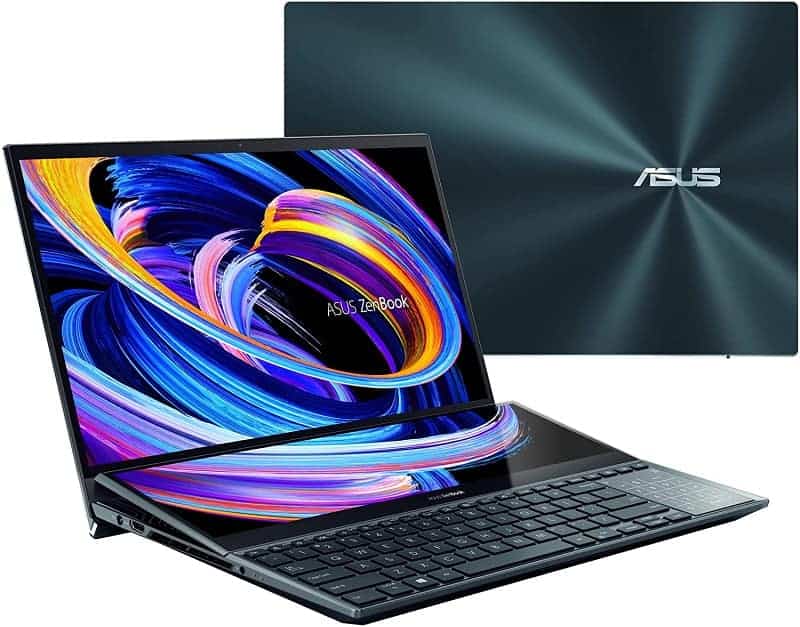
CPU
Intel Core i7-10870H / i9-10980HK / 11900H
Graphics
Nvidia GeForce RTX 3060 / 3070 / 3080
RAM
16GB / 32GB DDR4
Storage
1TB SSD
Screen Size
15.6”
Max Refresh Rate
60Hz
- fairly powerful core components
- 100% sRGB, DCI-P3, Adobe RGB coverage
- OLED display with great contrast
- second screen feature useful for creators
- great build quality
- no SD card reader
- poor battery life
- loud
- expensive
- keyboard & trackpad may be uncomfortable for some
The Asus ZenBook Pro Duo 15 has many superb quality features and has the potential to be a great OLED laptop, though falls slightly short due to a couple of questionable design choices. It’s still definitely worth considering though if these aspects don’t put your off.
Starting with the positives, the 2021 version of the machine comes with a powerful CPU & CPU combo in the way of the Intel Core i9-10980HK processor and the Nvidia RTX 3070 graphics card. The RTX 3070 has a max TGP of 110W with Dynamic Boost, which is up there with most gaming laptops that pack the same GPU. Although, as with all OLED screens, you will be capped at an effective 60FPS by the 60Hz display, you can definitely game on this machine as long as you turn the in-game resolution down to 1080p. An Intel 12th gen version of the same laptop was released in 2022, which comes with options for either an Intel Core i7-12700H or i9-12900H processor, but seems to be limited to the RTX 3060 GPU for some reason. You also get the option for a 1080p OLED display, should 4K resolution be unnecessary for you and you wish to save some money.
The main OLED display is terrific, with great contrast and 100% color gamut replication across the sRGB, DCI-P3, and Adobe RGB spaces, making it ideal for color-based workflows. The peak brightness is merely adequate rather than stellar, but should be fine for most indoor environments. The secondary 3840 x 1100 display between the main display and keyboard has touchscreen functionality and is useful for displaying different windows of whatever software you are using if you’re a creator. There is a Control Panel app created by ASUS that can occupy the second screen which can give more streamlined functionality to Adobe Premiere, After Effects, Photoshop, and Lightroom Classic.
Onto the negatives: whilst the lack of an SD card wouldn’t necessarily be that big of a deal for other laptops, the Asus ZenBook Pro Duo 15 is designed specifically with creatives in mind, so its absence here is fairly irritating. The fans on this laptop also get very loud when its put under any sort of strain: not ideal if you’re using this thing in an office space. The keyboard with a trackpad placed to the right-hand side (to make space for the second screen) can be a bit awkward to use, and we’d recommend using a mouse. Finally, the battery life is pretty poor: you’ll get not more than 4 hours of general usage at 50% brightness (assuming both screens are on), which really just isn’t good enough for working on the move. Still, if these critiques don’t put you off, and you can afford the steep asking price, there is still much to like in this quality dual-screen workstation machine.
Things to consider when buying an OLED laptop
What is an OLED laptop display?
OLED (Organic Light Emitting Diode) is a display technology that uses a layer of luminescent organic compound that emits light when an electrical current passes through it. This means, unlike LED displays, a backlight is not needed, so these screens are capable of being much thinner. OLED technology also has superior brightness, fields of view, and often a better contrast ratio than other screen tech.
AMOLED vs OLED
AMOLED (Active Matrix Organic Light Emitting Diode) screens are essentially a sub-type of OLED displays, which have an additional TFT (Thin Film Transistor) layer that acts as an electrical switch for each pixel in the displays, allowing for greater control and flexibility. AMOLED is typically the version of the technology you will see most commonly in smaller screen devices. This is because the TFT layer allows for greater variance in screen size compared to regular OLED displays.
OLED gaming laptops
Currently, you are only able to buy OLED laptops that have a maximum refresh rate of 60Hz. This is too low for what we’d usually look for in a gaming laptop (the next step up, 100Hz, is usually the standard). Although you can definitely game at this refresh rate (as console owners had to do until the latest generation Xbox / PlayStations), it will hinder your competitiveness in fast-paced online shooters as the maximum Frames Per Second you can effectively experience will be 60FPS. Hopefully, we’ll see faster displays in the not too distant future, as the technology is already there in OLED monitors and TVs for 120Hz screens.
Are OLED laptops expensive?
In almost all instances, an OLED or AMOLED laptop will cost more than its non-OLED counterpart. If you prioritize screen contrast, colors, and brightness for the reasons we’ve already mentioned though, then there isn’t really any other display that can compete, so often the extra money is worth it.
What is the risk of OLED laptop burn-in?
By far the biggest drawback of OLED panels is their susceptibility to image burn-in: this occurs when the same image is present on the display for an extended period of time, in the same position (the HUD on a first-person shooter game for instance) causing a ‘ghost’ of the image to remain scarred onto the screen, even when you change to a different image. This can be temporary or permanent. The most recent OLED panels are more resistant to burn-in, but it can still be a danger when gaming especially. As long as you take regular breaks between games though, you should be alright.
Best OLED laptop FAQs
Are OLED laptops better for eyes?
ASUS, LG and other manufacturers of OLED displays do claim that OLED screens are better for your eyes than LCD or LED alternatives. This is because there is less blue light and less flickering in OLED laptops compared to the other types, which are the leading causes of eye strain/fatigue. Whilst this is true, it’s pretty straightforward to simply apply a filter to your alternative panel type to reduce both of these harmful effects, so, unless you have some aversion to doing this, eye strain shouldn’t be a deciding factor when working out which laptop display type to buy.
Is OLED better than 4K for laptops?
It doesn’t make much sense to ask ‘is OLED better than 4K for laptop screens?’ as the two refer to different things and you can actually have a laptop display that is both 4K and OLED.
OLED is a panel type (as opposed to the most common IPS panel type) which has superior contrast ratio and blackpoint, and usually very good color replication. Although most OLED laptop displays aren’t of a high enough refresh rate for gaming, some are, and they have the advantage of very high response times.
4K signifies the resolution of the screen (the number of pixels it has) and is pretty much the highest you can get on a laptop screen. Higher resolution displays are better for seeing detail, but cost more money and usually don’t operate at as high refresh rates.
What is the cheapest OLED laptop?
OLED screens are high-end devices, so a laptop that has one will automatically cost more money. The cheapest OLED laptop we’d recommend is the ASUS ZenBook 13 with Ryzen 5000 series CPU options. Although you can get some OLED laptop models for less money, we wouldn’t recommend them, whereas the ZenBook 13 is a solid performer, assuming you can put up with the lack of a touchscreen, headphone jack, and poor webcam.
Other laptop guides
- Best laptop for video editing
- Best laptop for animation
- Best 4K laptop
- Best touch screen laptop
- Best AMD Ryzen 6000 series laptop
- Best Samsung laptop
- Best Evoo laptop
- Best pink laptop
- Best i7 Windows laptop
- Best laptop stand
- Best laptop table & laptop tray
Best OLED laptop 2024: Final Word
This has been our best OLED laptop buyer’s guide for 2024, we hope it has helped you find the right device for your needs. If it turns out your interest is not limited to OLED laptops, then do have a look at our other laptop guides for more options. Alternatively, see our best gaming laptop page if gaming is your main focus.








